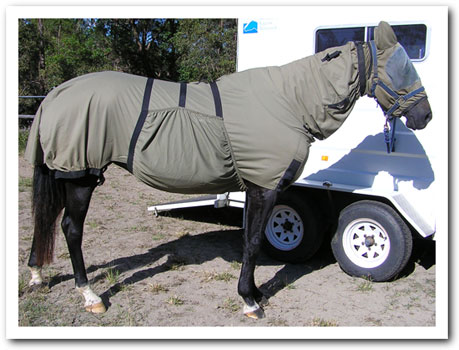Queensland Itch
This is an exasperating condition where the horse has developed hyper-sensitivity to the saliva of biting insects especially the little ‘midgies’ which get busy at dawn or dusk!
These tiny insects are abundant around ponds or anything wet for that matter which is why they thrive in sub-tropical regions like northern NSW and Queensland.
Afflicted horses are driven to the point where they itch and rub themselves raw. Permanent scarring can result.
The approach to treating the problem to date primarily focuses on barriers: topical treatments and physically trying to prevent the insects having access to the skin of the horse with full body insect repellent impregnated covers.
An allergy is an exaggerated inflammatory response of the horse’s immune system to proteins in the saliva of these midges and other flying, biting insects. The horse’s body produces a flood of ‘histamines’ to make the cell membranes more porous in order to expel the allergen, causing local inflammation and irritation.
However, think about it:
- “Why does a horse become allergic when it wasn’t before?”
- “Why, out of multiple horses in the same paddock with the same exposure to midges, are only some horses allergic?”
It is a problem that needs to be addressed as much from the inside as from the outside.
A genetic predisposition is one possible answer as is a change in the horse’s metabolism caused by chronic deficiencies and imbalances in the diet which disrupt the normal functioning of the immune system.

Diet?
There certainly exists considerable anecdotal evidence that horses previously affected with Queensland Itch showed either a partial or complete reduction of symptoms when any of the following items were added to the diet:
- Dried salt bush leaves (high in salt, selenium and sometimes sulphur)
- Linseed for Omega 3’s (Strengthens cell membranes)
- Salt (approx 10gms per 100kg or 2-3 tablespoons for a 500kg horse)
Read Feeding Salt - High spec Supreme multi Vit & Min, the formula includes organic copper, organic zinc, organic sulphur (MSM) and organic selenium, all the B Vitamins, and Vitamin C, all of which have anti-histamine properties.
By altering your feeding programme, instead of just treating the symptoms (which is like trying to close the stable door after the horse has bolted) you are taking steps to ‘allergy-proof’ your horse and prevent it happening in future.
Having said this it is an unfortunate fact that it is a very difficult condition to ‘cure’ in some cases.
Feeding Regime
Feeding Regime for ‘Queensland Itch’
Important: Make any diet changes gradually over 2 weeks.
- Where possible deny access to grass in rapid growth mode by yarding or stabling with ad lib hay for at least part of the day. The fibre in the hay feeds the flora in the hind-gut which then produce, as a by-product, plenty of all the B Vitamins helping to allergy-proof your horse.
- Delete lucerne, ‘sweet’ feeds, or other molassed grains from the diet and replace them with non-molassed beets, white chaffs and Linseed oil
- Add 10gms/100kgs BW of salt to the daily feed, (build up gradually)
- Build up to 60gms of linseed (boiled or freshly crushed in a coffee grinder)
- Introduce Virgin Coconut Oil
- Feed a high spec multi like Supreme Vit & Min
It could take several months for the new diet to make a difference to your horse. In the meantime continue with external barriers and treatments. As far as topical treatments go there is no one ‘cure’ that works in all cases. It is a case of trial and error until you find the most suitable solution for your horse.
People have success with the following: Brute, Permoxin, Avon Skin So Soft, a mix of Eucalyptus Oil, Citronella Oil and Tea-Tree Oil, a tablespoon of Menthol based Gel dissolved in water and sponged onto affected areas .
(the latter is recommended by John Kohnke DVM)
 Calm Healthy Horses
Calm Healthy Horses